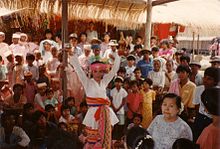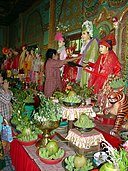Nat (deity)


Thenats(နတ်;MLCTS:nat;IPA:[naʔ]) are god-like spirits venerated inMyanmarand neighbouring countries in conjunction withBuddhism.They are divided between the 37Great Natswho were designated that status byKing Anawrahtawhen he formalized the official list of nats. Most of the 37Great Natswere human beings who met violent deaths.
There are two types ofnatsin Burmese Belief:nat sein(နတ်စိမ်း) which are humans that were deified after their deaths and all the other nats which are spirits of nature (spirits of water, trees etc.).
Much likesainthood,natscan be designated for a variety of reasons, including those only known in certain regions in Burma.Natworship is less common in urban areas than in rural areas and is practised amongethnic minorities of Myanmaras well as in mainstreamBamarsociety. However, it is among theTheravada BuddhistBamar that the most highly developed form of ceremony and ritual is seen.[1]
Every Burmese village has anat kun(နတ်ကွန်း) ornat sin(နတ်စင်) which essentially serves as a shrine to thevillage guardiannatcalled theywa saung nat(ရွာစောင့်နတ်). Individual houses also have a shrine to a nat, usually a coconut is hung on a corner of the house or property, surrounded by perfume as an offering. One may inherit a certain member or in some instances two of the 37Great Natsasmi hsaing hpa hsaing(မိဆိုင်ဖဆိုင်;lit. 'mother's side, father's side') from one or both parents' side to worship depending on where their families originally come from. One also has a personal guardian deity calledko saung nat(ကိုယ်စောင့်နတ်).[2]
Nat worship and Buddhism[edit]

Academic opinions vary as to whether Burmese Buddhism and Burmese spirit worship are two separate entities, or merged into a single religion.[citation needed]As with a rise ofglobalization,the importance of the nat religion on modern Myanmar and its people has been diminished. The formalizing of the official 37Great Natsby KingAnawrahta(1044–1077) ofBagan,has been interpreted as Burmanisation and establishment ofBamar supremacyin theIrrawaddyvalley after the unification of the country and founding of theFirst Burmese Empire.[1] Worship ofnatspredates Buddhism in Burma. With the arrival of Buddhism, however, thenatswere syncretically merged with Buddhism.[citation needed]
Nat worship and ecology[edit]

The widespread traditional belief among rural communities that there are forest guardian spirits calledtaw saung nats (တောစောင့်နတ်) and mountain guardian spirits calledtaung saung nats (တောင်စောင့်နတ်) appears to act as a deterrent against environmental destruction, up to a point. Indiscriminate felling, particularly of large trees, is generally eschewed owing to the belief that they are dwellings of tree spirits calledyokkazo(ရုက္ခစိုး;tree spirit) and that such an act would bring the wrath of thenatupon the perpetrator.[3]
Popular nat festivals[edit]


The most importantnatpilgrimage site in Burma isMount Popa,an extinct volcano with numerous temples and relic sites atop a 1300 metre-tall mountain located nearBaganin central Burma. The annual festival is held on the full moon of the month ofNatdaw(December) of theBurmese calendar.[4]Taungbyone, north ofMandalayinMadaya Township,is another major site with the festival held each year starting on the eleventh waxing day and including the full moon in the monthWagaung(August).[5]Yadanagu atAmarapura,held a week later in honour of Popa Medaw ( "Mother of Popa" ), who was the mother of the Taungbyone Min Nyinaung ( "Brother Lords" ), is also a popular nat festival.[2]
Natsare ascribed human characteristics, wants, and needs; they are flawed, having desires considered derogatory and immoral in mainstream Buddhism. During anat pwè,which is a festival during whichnatsare propitiated,nat kadaws (နတ်ကတော်"wife of the spirit",[6]i.e. "medium,shaman") dance and embody thenats.Historically, thenat kadawprofession was hereditary and passed from mother to daughter. Until the 1980s, fewnat gadaws were male. Since the 1980s, persons identified by outsiders astrans womenhave increasingly performed these roles.[6]
Music, often accompanied by ahsaing waing( "orchestra" ), adds much to the mood of thenat pwè,and many are entranced. People come from far to take part in the festivities in various shrines callednat kunornat naan,get drunk onpalm wineand dance wildly in fits of ecstasy to the wild beat of the Hsaing waing music, possessed by thenats.[4]
Whereasnat pwès are annual events celebrating a particular member of the 37Great Natsregarded as the tutelary spirit in a local region within a local community, with familial custodians of the place and tradition and with royal sponsorship in ancient times, hence evocative of royal rituals, there are alsonat kannah pwès where individuals would have a pavilion set up in a neighbourhood and the ritual is generally linked to the entire pantheon ofnats.Thenat kadaws as an independent profession made their appearance in the latter half of the 19th century as spirit mediums, andnat kannahs are more of an urban phenomenon which evolved to satisfy the need of people who had migrated from the countryside to towns and cities but who wished to carry on their traditions oryo-yaof supplicating themi hsaing hpa hsaingtutelary deities of their native place.[1]
List of official nats[edit]


KingAnawrahtaof Bagan (1044–1077) designated an official pantheon of 37Great Natsafter he had failed to enforce a ban onnatworship. His stratagem of incorporation eventually succeeded by bringingnatstoShwezigon Pagodaportrayed worshippingGautama Buddhaand by enlistingŚakra,aBuddhist protective deity,to head the pantheon above the Mahagiri nats asThagyamin.[4][7]Seven out of the 37Great Natsappear to be directly associated with the life and times of Anawrahta.[7]
The official pantheon is made up predominantly of those from the royal houses ofBurmese history,but also containsnatsofThai(Yun Bayin) andShan(Maung Po Tu) descent; illustrations of them show them in Burmese royal dress. Listed in proper order, they are:
- Thagyamin(သိကြားမင်း)
- Min Mahagiri(မင်းမဟာဂီရိ)
- Hnamadawgyi(နှမတော်ကြီး)
- Shwe Nabay(ရွှေနံဘေး)
- Thonbanhla(သုံးပန်လှ)
- Taungoo Mingaung(တောင်ငူမင်းခေါင်)
- Mintara(မင်းတရား)
- Thandawgan(သံတော်ခံ)
- Shwe Nawrahta(ရွှေနော်ရထာ)
- Aungzwamagyi(အောင်စွာမကြီး)
- Ngazi Shin(ငါးစီးရှင်)
- Aung Pinle Hsinbyushin(အောင်ပင်လယ်ဆင်ဖြူရှင်)
- Taungmagyi(တောင်မကြီး)
- Maungminshin(မောင်မင်းရှင်)
- Shindaw(ရှင်တော်)
- Nyaunggyin(ညောင်ချင်း)
- Tabinshwehti(တပင်ရွှေထီး)
- Minye Aungdin(မင်းရဲအောင်တင်)
- Shwe Sitthin(ရွှေစစ်သင်)
- Medaw Shwezaga(မယ်တော်ရွှေစကား)
- Maung Po Tu(မောင်ဘိုးတူ)
- Yun Bayin(ယွန်းဘုရင်)
- Maung Minbyu(မောင်မင်းဖြူ)
- Mandalay Bodaw(မန္တလေးဘိုးတော်)
- Shwe Hpyin Naungdaw(ရွှေဖျင်း နောင်တော်)
- Shwe Hpyin Nyidaw(ရွှေဖျင်း ညီတော်)
- Mintha Maungshin(မင်းသား မောင်ရှင်)
- Htibyuhsaung(ထီးဖြူဆောင်း)
- Htibyuhsaung Medaw(ထီးဖြူဆောင်း မယ်တော်)
- Pareinma Shin Mingaung(ပရိမ္မရှင် မင်းခေါင်)
- Min Sithu(မင်းစည်သူ)
- Min Kyawzwa(မင်းကျော်စွာ)
- Myaukhpet Shinma(မြောက်ဘက်ရှင်မ)
- Anauk Mibaya(အနောက် မိဘုရား)
- Shingon(ရှင်ကုန်း)
- Shingwa(ရှင်ကွ)
- Shin Nemi(ရှင်နဲမိ)
See also[edit]
References[edit]
- ^abcBrac de la Perriere, Benedicte."The Spirit-possession Cult in the Burmese Religion"(PDF).dhammaweb.net.Archived(PDF)from the original on 2009-03-04.Retrieved2008-09-14.
- ^abSpiro, Melford(1996).Burmese Supernaturalism.Transaction Publishers. p. 114.ISBN978-1-4128-1901-5.
- ^Dr Sein Tu."Traditional Myanmar Folk Beliefs and Forest and Wildlife Conservation".Perspective (January 1999).Retrieved2008-09-13.[permanent dead link]
- ^abcMaung Htin Aung (February 1958)."Folk-Elements in Burmese Buddhism".The Atlantic Monthly.Archivedfrom the original on 2008-09-06.Retrieved2008-09-11.
- ^Shwe Mann Maung."The Taung Byone Nat Festival".Perspective (August 1997). Archived fromthe originalon 2004-07-17.Retrieved2008-09-11.
- ^abHo, Tamara C.; Discourse (Fall 2009)."Transgender, Transgression, and Translation: A Cartography of Nat Kadaws".Discourse.31(3): 273–317.doi:10.1353/dis.2009.a402310.
- ^abDeCaroli, Robert (2004).Haunting the Buddha: Indian Popular Religions and the Formation of Buddhism.Oxford University Press,US.ISBN978-0-19-516838-9.Retrieved2008-09-13.
- 'King Mae Ku: From Lan Na Monarch to Burmese Nat', in: Forbes, Andrew, and Henley, David,Ancient Chiang MaiVolume 1. Chiang Mai, Cognoscenti Books, 2012.
- Salek, Kira (May 2006). "Myanmar's River of Spirits".National Geographic Magazine.pp. 136–157.
- U Kyaw Tun; et al. (2005-01-15)."Nat in My Classroom!".Tun Institute of Learning. Archived fromthe originalon 2012-12-03.Retrieved2006-07-03.
- Temple, R.C. (1906).The Thirty-seven Nats-A Phase of Spirit-Worship prevailing in Burma.
- Hla Tha Mein
External links[edit]
- "Images of the 37 nats".NYPL Digital Gallery.
- Nat belief and BuddhismPhoto essay by Claudia Wiens
- The Nats - Online Burma/Myanmar Library
- Friends in High PlacesPreview of a documentary film by Lindsey Merrison
- Nat DanceYouTube
- Mintha TheaterDance theater in Mandalay, Burma.
- Spirit of Burma 2006
- Nat Pwè recordings
- The Nat Spirits and Burmese AnimismWindows on Asia,Michigan State University
- Myanmar Cyclone Brings Rise in Centuries-Old 'Nat' WorshipThe Wall Street Journal,June 30, 2008, video and photo slideshows
- Festival brings noise and colour to TaungbyoneZaw Win Than,The Myanmar TimesVol. 22 No. 430, August 4–10, 2008
- Myanmar Nat Pwe in BagoFlickrphotos by Boonlong1
- My House Nat Can Whip Your House NatEthan Todras-Whitehill,Student Traveler,2006-11-24
- An account of the Taungbyone 2010 nat pwe spirit festival at Arcane CandyPart 1andPart 2
- Myanmar's River of SpiritsKira Salak,National Geographic.May 2006
- The Thirty Seven Nats. A Phase of Spirit-Worship prevailing in Burma | Southeast Asia Digital Library
- Counting to 37 Sir Richard Carnac Temple and the Thirty Eighth NatBy Sally Bamford 2019.

